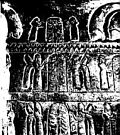 |
Tour Armenia
The story of the Armenians is filled with myths and historical facts, and it is sometimes hard to tell the difference between the two. For a country so old, and so intertwined with ancient historical events, it is easy to dismiss myths as pure legends. But a look at the root definition of the word Myth can be an eye-opener: a myth is not a lie, but a story that tells a greater truth.
The Armenian language is a part of the Indo-European (Indo-Aryan) language tree, and the Indo-Europeans are believed to have originated on or near the Armenian Plateau, migrating throughout Western and Central Asia and Europe. Indo-European took more than a root language with them, they brought ideas and beliefs distinct to their native home. Among these were the zodiac and the myths that sprung from their origins. One of the destinations for the Indo-European culture was Northern India, another the Doric culture in Greece. The Sanskrit language in particular has many root words identical to those found in Armenian.
There is also a common mythology between the cultures, beginning with the myth of Vishnu in Sanskrit, and ending with Dionysus in Greek mythology. A later version of the same myth was developed in Egypt, for a new god Isis. In Armenia, the myth was represented by the god Ara Geghetsik, with origins from around 2400 BCE, the beginning of the old Armenian calendar. Another is the Armenian god-king Haik, the forerunner of the Greek Hercules.
The goddess of death by destruction is a common god form in ancient cultures, and the myth of Shiva, the most terrible and destructive of Hindu goddesses is firmly rooted in Armenian tradition. In the goddess Anahit, the Armenians have a myth so old and close to Shiva, it is considered proof of Indo-European influence on the North Indian culture. Unlike Shiva, Anahit gradually tamed her destructive influences and later generations knew her as the goddess of fertility and birth, and in Greece she was known as Artemis.
Other gods and goddesses with roots in ancestral Armenia are Aramazd (Zeus), Nouneh (Athena), Vahag’n (Hephaestus), Astghik (Aphrodite), Tir (Apollo) and Tork Angegh (Aries).
See The Armenian Gods
(update 2003)
|



